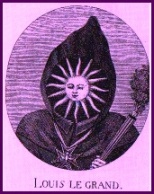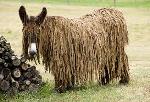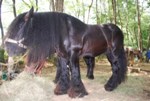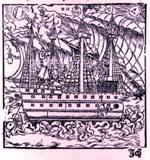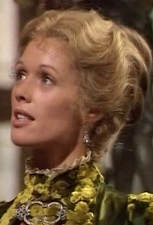Angélique in Revolt
This morning when I decided I should do some more work on these pages especially as Anne Golon's landmark  90th birthday is fast approaching, and I want to get them completed in time for that date, I certainly didn't think I was going to change direction and start a whole new book (I had intended to return to Countess Angélique to complete that section). But apparently the fates have decided that I should complete this book instead of moving further afield in the series.
90th birthday is fast approaching, and I want to get them completed in time for that date, I certainly didn't think I was going to change direction and start a whole new book (I had intended to return to Countess Angélique to complete that section). But apparently the fates have decided that I should complete this book instead of moving further afield in the series.
For me, 'Angélique in Revolt' has one of two (the other can be found in 'Angélique in Love') defining moments where Angélique comes into her own as absolute 'woman.' She is in the throes of battle, beleaguered with little hope of success when she espies an envoy of the King, one Monsieur de Barenne who had previously paid her such 'gallant court' - and asks him to convey a message to the King.
 "She leant over and called out in a mocking voice that rang out in a long echo: 'Greetings, Monsieur de Barenne. Go to His Majesty
and say that Trifle wishes to be remembered kindly to him!'
"She leant over and called out in a mocking voice that rang out in a long echo: 'Greetings, Monsieur de Barenne. Go to His Majesty
and say that Trifle wishes to be remembered kindly to him!'
When they told the King what she had said, he went pale. He shut himself up alone in his study and stayed there for several hours, with his face in his hands. Then he sent for the Minister of War and told him to do everything in his power to crush the Poitou rebellion before the following spring."
(From Angélique in Revolt translated by Marguerite Barnett)
Poitou has a history of strong women at its helm, Angélique in Revolt picks up the thread in a timely manner and Angélique, the eponymous heroine suffers every degradation in this uprising which has been caught up in the infinitely more sinister banner of religious warfare! This then and the subsequent persecution of the Huguenots which followed are the two major historical areas of the book that will feature on this page.
I make no apologies for adding two book covers to this page, I am fascinated by the above non-French version, which until I looked at it more closely today, firmly believed it was a Hebrew publication, but it seems perhaps not, so I'm speculating that it may be Turkish. But why I find it fascinating is that it is quite obviously based on the 1964 Pan version of this book (artwork not credited) which made up the first six books I ever bought and probably gave me a lasting image of how I believed Angélique should look. This picture keeps the general layout, the hairstyle and props, even the fairly obvious British redcoat in the background, but the facial features have been altered as have the sleeves and collar of the nightgown. I'm guessing that the features were changed for a) copyright reasons and b) to make it easier for the potential reader to relate to the heroine. It has often been said, when various factions of Angélique fans start 'casting' their favourite characters, the British choose favourite British actors and actresses, the Americans choose from their favoured stars and Europeans will usually go for a mixture as they have access to English television and films, whereas the English-speaking public tend not to venture into the unknown.
An American friend of mine was very taken with Jessica Benton of 'The Onedin Line' whom she's never seen before visiting us and was impressed with her range of acting skills (from your tearaway to wife of a Member of Parliament) which could echo Angélique of the marshes to wife of the Count du Plessis-Bellière (she had not yet earned her rank in her short-lived marriage to Joffrey). For me - the perfect pairing to portray Angélique and Joffrey, conversely, would be a pair of American actors - Susan Sullivan and David Selby who appeared as man and wife in the long-running soap 'Falcon Crest'.

I am also devoting space on this page to the Poitou Donkey of which we heard so much in Book 1 as Angélique's father enters into a business partnership with Joffrey de Peyrac, the Count of Toulouse and the reluctant Angélique's future husband.
Book 1 already covers a multitude of subjects and as this book has returned us to Poitou then I believe this is a fitting place to feature this unusual, rare and possibly unique breed of endearing donkey.
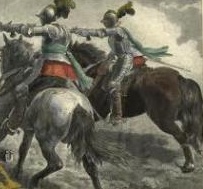 In this episode of her story, Angélique suffers the greatest degradation that can befall a woman at any stage of her life, but to be so brutally raped, for daring to confront the male on his own terms, so that he can show his supremacy is unforgiveable. On top of that act of brutality came the second greatest vile act that could have been perpetrated on that particular night - the defenceless slaughter of a babe, still in arms - all to satisfy the hurt pride of an arrogant brute. He was put into a uniform, given charge of a few men whom he likely bullied because of his rank and exerted his physical strength to subdue a woman! Bravo Captain Montadour, another shining example of French manhood!
In this episode of her story, Angélique suffers the greatest degradation that can befall a woman at any stage of her life, but to be so brutally raped, for daring to confront the male on his own terms, so that he can show his supremacy is unforgiveable. On top of that act of brutality came the second greatest vile act that could have been perpetrated on that particular night - the defenceless slaughter of a babe, still in arms - all to satisfy the hurt pride of an arrogant brute. He was put into a uniform, given charge of a few men whom he likely bullied because of his rank and exerted his physical strength to subdue a woman! Bravo Captain Montadour, another shining example of French manhood!
The one ray of hope that comes from this brutal encounter is the conception of Honorine - Angélique's daughter with the flaming red hair and black eyes of her monster of a sire - but Honorine has her place elsewhere in this series and she will prevail.
The Missing Character
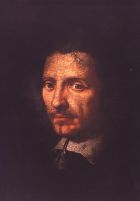 Before I concentrate on the two subjects I have chosen - the English-reading public really were cheated on many levels - the story you all know of who or what gender was 'Sergeanne' and even when that was revealed why were we led to believe they were brother and sister? Then there's those three books that haven't been translated - even today, someone on Facebook, having discovered the fan pages is asking why they were never translated - 'the answer my friend is written in the wind, the answer is written in the wind' (with apologies to Bob Dylan's 'Blowin' in the Wind'). Since exchanging news and views with readers from other countries, we discover that great chunks of subject matter have been edited out of the English versions and then, on reading the books in Polish I discovered the excision of an entire character! Whatever did Audiger ever do to deserve such treatment? All he wanted to do was to offer love and protect the mysterious woman without a name with whom he took long walks. He even offered her marriage not knowing whether she were a servant or great lady (both as it happens). He is not a long-lived character, but to excise him in such a way, to remove all references to him as the story-line progressed and then all future references must have been an editing feat in itself! Imagine if there had been one tiny slip-up. (I wonder what he looked like?) No wonder Anne Golon wants to complete her Intégrale!
Before I concentrate on the two subjects I have chosen - the English-reading public really were cheated on many levels - the story you all know of who or what gender was 'Sergeanne' and even when that was revealed why were we led to believe they were brother and sister? Then there's those three books that haven't been translated - even today, someone on Facebook, having discovered the fan pages is asking why they were never translated - 'the answer my friend is written in the wind, the answer is written in the wind' (with apologies to Bob Dylan's 'Blowin' in the Wind'). Since exchanging news and views with readers from other countries, we discover that great chunks of subject matter have been edited out of the English versions and then, on reading the books in Polish I discovered the excision of an entire character! Whatever did Audiger ever do to deserve such treatment? All he wanted to do was to offer love and protect the mysterious woman without a name with whom he took long walks. He even offered her marriage not knowing whether she were a servant or great lady (both as it happens). He is not a long-lived character, but to excise him in such a way, to remove all references to him as the story-line progressed and then all future references must have been an editing feat in itself! Imagine if there had been one tiny slip-up. (I wonder what he looked like?) No wonder Anne Golon wants to complete her Intégrale!
The Wars of Religion
"Wars of Religion and La Rochelle
The Wars of Religion were a series of conflicts in 16th century France fought between Catholics and French Protestants (known as Huguenots) over the rights of the latter to follow their own form of worship. They ended in 1598 with the Edict of Nantes, a charter that granted a degree of religious freedom to Protestants. Once again Poitou-Charentes features in this important period of French history – not least because La Rochelle had by then become a centre of French Protestantism.
'A true representation of the King's Naval Army, commanded by Monsieur Admiral, to suppress the rebels during the period 12-15th September 1625.'
Others towns in Poitou-Charentes, such as Saintes and Poitiers, also had sizeable Protestant populations. After the infamous St Bartholomew Day’s Massacre in 1572 – in which thousands of them were slaughtered across the country – many French Protestants fled to La Rochelle, which was already largely Protestant, had strong defences and had access to the relative safety of the sea.
Catholic troops besieged the town, although the siege ended with a negotiated settlement in the summer of 1573. Freedom of worship was then granted to French Protestants in just three towns – Nîmes, Montauban and La Rochelle itself. The more wide-ranging Edict of Nantes in 1598 appeared to bring the religious conflicts to an end. In truth, it was little more than a cease-fire.
In the 17th century conflict again broke out between the majority Catholics and minority Protestants and in 1627 La Rochelle once again came under siege as Louis XIII’s top adviser and official Cardinal Richelieu personally led a military campaign against the Huguenots. Despite support from the English – who landed a force on nearby Île-de-Ré – the French Protestants eventually succumbed after 14 weary months.
Limited rights still gave Protestants some protection until 1685 when Louis XIV formally revoked the Edict of Nantes, effectively outlawing Protestantism in France. Many Protestants, including from La Rochelle, chose to flee the country, with some choosing England as their new home."
Source Discover Poitou-Charentes
The Huguenots were well received in England and they brought many skills in finance, industry and arts with them, contributing to the rise of British industry and trade.
More information on the Edict of Nantes here
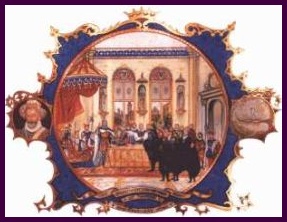
The Proclamation of the Edict of Nantes 23rd February 1598 by Henry IV of France, from a miniature contained in a triptych of the Huguenot Ancestry of TRH Prince William and Prince Henry of Wales, researched by Royston Gambier, F.S.G., engrossed and illuminated by Revd D.N.Chesters O.B.E., Writer to Her Majesty's Remembrancer, and photographed by Trevor J. Moore.
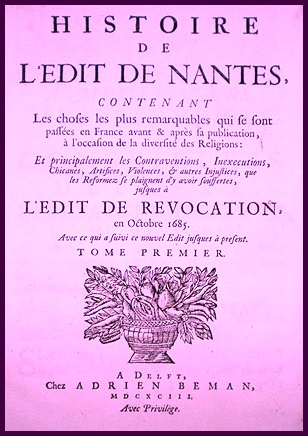
Persecution of the Huguenots
"During the infamous St Bartholomew Massacre of the night of 23/24 August, 1572 more than 8 000 Huguenots, including Admiral Gaspard de Coligny, Governor of Picardy and leader and spokesman of the Huguenots, were murdered in Paris. It happened during the wedding of Henry of Navarre, a Huguenot, to Marguerite de Valois (daughter of Catherine de Medici), when thousands of Huguenots converged on Paris for the wedding celebrations.
 It was Catherine de Medici who persuaded her weakling son Charles IX to order the mass murder, which lasted three days and spread to the countryside. On Sunday morning August 24th, 1572 she personally walked through the streets of Paris to inspect the carnage. Henry of Navarre's life was spared when he pretended to support the Roman Catholic faith. In 1593 he made his "perilous leap"and abjured his faith in July 1593, and 5 years later he was the undisputed monarch as King Henry IV (le bon Henri, the good Henry) of France. When the first rumours of the massacre reached the Vatican in Rome on 2 September 1572, pope Gregory XIII was jubilant and wanted bonfires to be lit in Rome. He was persuaded to wait for the official communication. The very morning of the day that he received the confirmed news, the pope held a consistory and announced that "God had been pleased to be merciful". Then with all the cardinals he repaired to the Church of St. Mark for the Te Deum, and prayed and ordered prayers that the Most Christian King might rid and purge his entire kingdom (of France) of the Huguenot plague."
It was Catherine de Medici who persuaded her weakling son Charles IX to order the mass murder, which lasted three days and spread to the countryside. On Sunday morning August 24th, 1572 she personally walked through the streets of Paris to inspect the carnage. Henry of Navarre's life was spared when he pretended to support the Roman Catholic faith. In 1593 he made his "perilous leap"and abjured his faith in July 1593, and 5 years later he was the undisputed monarch as King Henry IV (le bon Henri, the good Henry) of France. When the first rumours of the massacre reached the Vatican in Rome on 2 September 1572, pope Gregory XIII was jubilant and wanted bonfires to be lit in Rome. He was persuaded to wait for the official communication. The very morning of the day that he received the confirmed news, the pope held a consistory and announced that "God had been pleased to be merciful". Then with all the cardinals he repaired to the Church of St. Mark for the Te Deum, and prayed and ordered prayers that the Most Christian King might rid and purge his entire kingdom (of France) of the Huguenot plague."
17th Century
Louis XIV (the Sun King, 1643-1715) began to apply his motto l'état c'est moi ("I am the state") and introduced the infamous Dragonnades - the billeting of dragoons in Huguenot households. He began with a policy of une foi, un loi, un roi (one faith, one law, one king) and revoked the Edict of Nantes on 22 October 1685. The large scale persecution of the Huguenots resumed. Protestant churches and the houses of "obstinates" were burned and destroyed, and their bibles and hymn books burned. Emigration was declared illegal. Many Huguenots were burned at the stake. Many Huguenots who did not find their death in local prisons or execution on the wheel of torture, were shipped to sea to serve their sentences as galley slaves, either on French galley ships, or sold to Turkey as galley slaves.
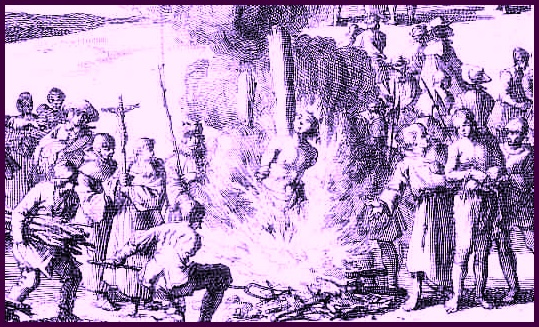
Scenes like these were common during the persecution of the Huguenots in France during the sixteenth and seventeenth century.
A vivid account of the life of galley-slaves in France is given in Jean Marteilhes's Memoirs of a Protestant, translated by Oliver Goldsmith, which describes the experiences of one of the Huguenots who suffered after the revocation of the Edict of Nantes.
Every Huguenot place of worship was to be destroyed; every minister who refused to conform was to be sent to the Hôpitaux de Forçats at Marseilles and at Valance. If he had been noted for his zeal he was to be considered "obstinate," and sent to slavery for life in such of the West-Indian islands as belonged to the French. The children of Huguenot parents were to be taken from them by force, and educated by the Roman Catholic monks or nuns.

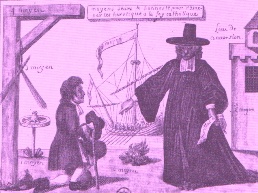
From the Gevaux Family Archives "the following contemporary images show aspects of Louis XIVth of France's persecution of the Huguenots, and his crude attempts to force them to recant their Protestant faith. By the time of the Revocation of the Edict of Nantes in October 1685, nearly a quarter of France was worshiping in Protestant temples. At a stroke, this royal decree took away their legal rights and opened them up to persecution and imprisonment. Some stayed, abjured their faith and accepted the Catholic yoke, others chose the dangers and uncertainty of exile."
At least 250 000 French Huguenots fled to countries such as Switzerland, Germany, England, America, the Netherlands, Poland and South Africa, where they could enjoy religious freedom. As many were killed in France itself. Between 1618 and 1725 between 5 000 and 7 000 Huguenots reached the shores of America. Those who came from the French speaking south of Belgium, an area known as Wallonia, are generally known as Walloons (as opposed to Huguenots) in the United States.
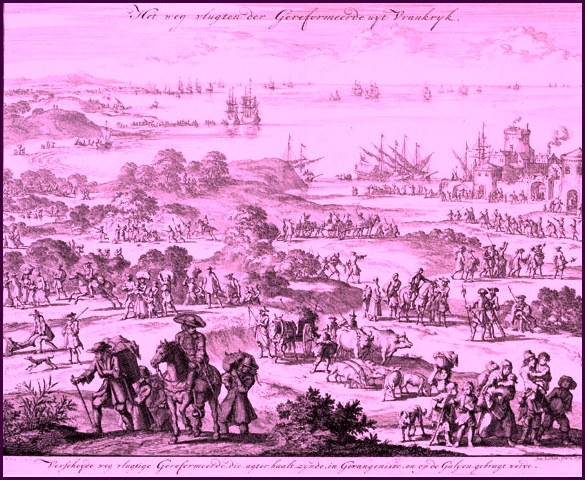
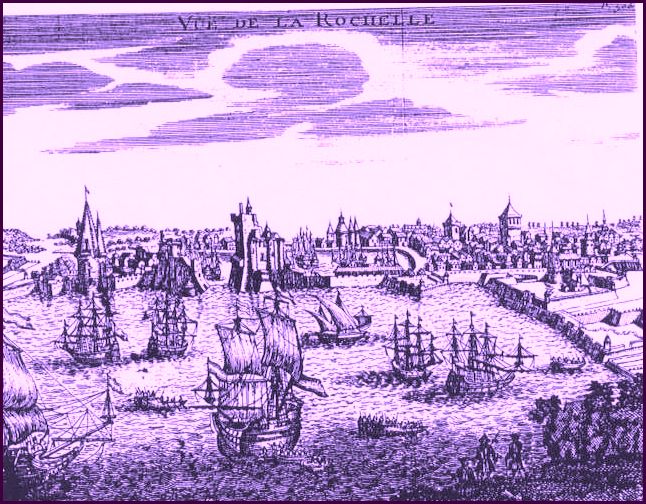
Fleeing La Rochelle by land and sea
The organised large scale emigration of Huguenots to the Cape of Good Hope in South Africa occurred during 1688 - 1689. However, even before this large scale emigration individual Huguenots such as François Villion (1671) and the brothers François and Guillaume du Toit (1686) fled to the Cape of Good Hope. In 1692 a total of 201 French Huguenots had settled at the Cape of Good Hope. Most of them settled in an area now known as Franschhoek ("French Corner"), some 70 km outside Cape Town, where many farms still bear their original French names.
A century later the promulgation of the Edict of Toleration on 28 November 1787 partially restored the civil and religious rights of the Huguenots in France.
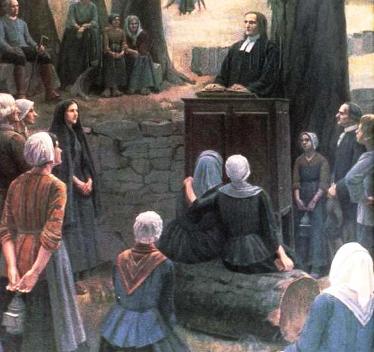
Huguenot worshippers at peaceful prayer.
The Huguenot Memorial in Franschhoek - South Africa
The well-known Huguenot Monument in Franschhoek commemorates the arrival of approximately 270 French Huguenots in the Cape circa 1687-89. They were fleeing religious persecution in France following the Revocation of the Edict of Nantes in 1685.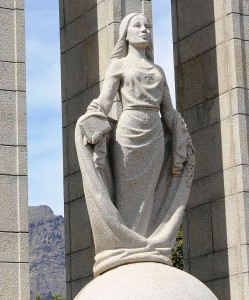
The monument incorporates a figure of a woman with a bible in her right hand and a broken chain in her left – the spirit of religious freedom. She is in the process of throwing off her cloak, the cloak of oppression. Above the three arches, which symbolise the Holy Trinity, is the sun of righteousness.
In the background, the colonnade lies in a semi-circle, symbolising the “spiritual bliss and peace of mind which have been found after so many years of persecution and so long a struggle” (Franschhoek – Gem of the South African Winelands, Jeremy Browne, 2007).
The date of inauguration of the Huguenot Monument? April 17, 1948, just 39 days before the National Party took power, ushering in 46 years of racial domination, religious chauvinism, injustice, persecution and oppression in South Africa. The first apartheid Prime Minister, Dr DF Malan, was a Huguenot descendent, as were many other National Party leaders. Talk about one person’s freedom being another person’s oppression!
Breaking the chains of religious subjugation and throwing off the cloak of oppression
On a colonnade near the adjacent Huguenot museum is the inscription Post Tenebras Lux (“after darkness, light”) the motto of the Protestants during the Reformation. This could very well have been the slogan of millions of South Africans who suffered under apartheid and who celebrated liberation after the first democratic elections in 1994. I’m sure this irony was lost on the many descendants of the Huguenots who enthusiastically voted for the National Party election after election.
London
The French Protestant Church of London (Église Protestante Française de Londres) is a Huguenot Protestant church in Soho Square, London. It is a registered charity under English law. This beautiful tympanum captures the art of the time in a modern and timeless manner.
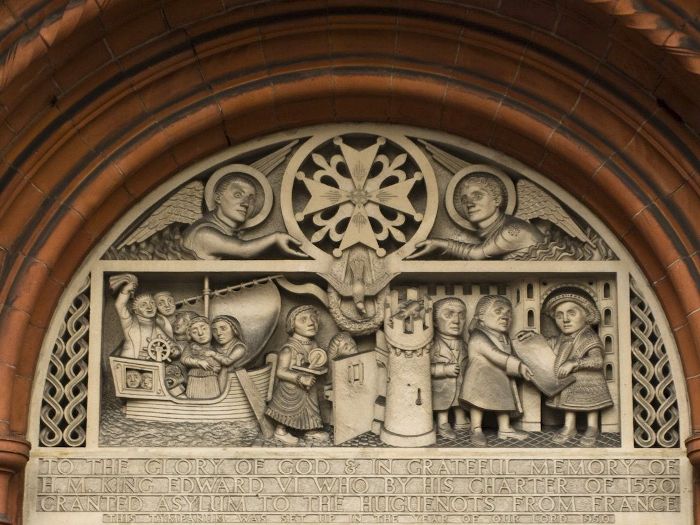
'To the Glory of God and in grateful memory of H.M. King Edward VI who by his charter of 1550 granted Asylum to the Huguenots from France. This tympanum was set up in the year of our Lord 1950'
The 'Poitou' - 1937
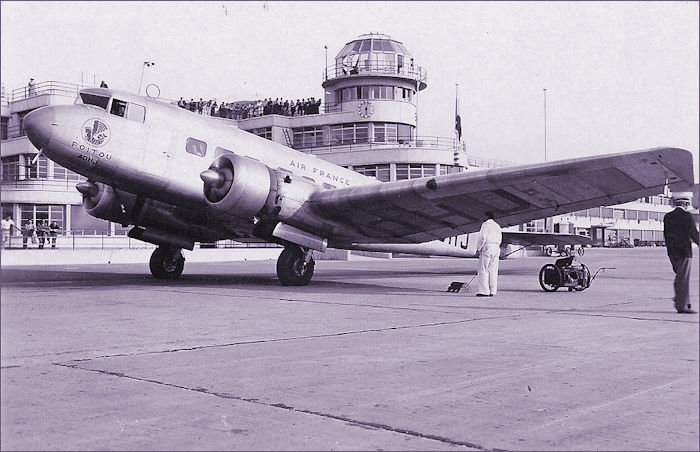
An Air France Bloch MB.220 named 'Poitou' on the tarmac of Le Bourget Airport on the outskirts of Paris in 1937
You might be wondering why I have included a 1930s aeroplane in the story of 'Angélique.' I think, as you read its story, especially its pivotal part in French history you will compare its heroism to our eponymous heroine. It's name is synonymous with Angéliques childhood, the place she returns to in the most troubled part of her life and from where she leads the revolt to avenge herself and her 'people.' Our aeroplane may not have been a 'rebel' but who knows what it must have gone through and achieved during WWII.
One other piece of whimsy I am allowing myself - we know that Anne Golon was a heroine doing WWII putting herself at risk on numerous occasions and cycling the length and breadth of France on a number of missions. Who can say with any certainty that she might not have stopped cycling on hearing a rumble of an aeroplane's throttle and looked up and given a friendly wave to a 'home' pilot? Who's to say that it might or might not have been the pilot of the 'Poitou' smiling down at an attractive woman on a bicycle who had raised her face up to the skies and wished him luck? It could have happened ....... I bet it did happen!
Now here's what I have found out about the Bloch MB.220 Fleet :
The Bloch MB.220 was a twin-engine transport aircraft built by the Marcel Bloch aircraft company making its maiden flight on June 11, 1936 at Villacoublay. Its design was largely inspired by the Douglas DC-2 with an all-metal coating, a low cantilever wing with a leading edge in a slight arrow and trailing edge perpendicular to the reference axis. Its crew consisted of two pilots and two stewards for a capacity of 16 passengers.
Air France commissioned a fleet of 16, giving each aircraft the name of a province: Alsace, Anjou, Aunis, Auvergne, Berry, Champagne, Flandre, Gascogne, Guyenne, Languedoc, Lorraine, Poitou, Provence, Roussillon, Saintonge and Savoie. The first of the machines were delivered in 1937 and used on the Paris - Marseille line. The first scheduled commercial flight was on July 20th, 1937. The MB 220 was much more comfortable than other aircraft in service in 1936: having Pullman armchairs with adjustable backrests, shelves designed to hold a cup securely, soundproofing, heating and ventilation. Passengers were served by a crew of three or four members depending on the line; the passenger capacity of the aircraft being sixteen people.
In addition to its regular commercial services, the MB.220 is used by the French government for official travel. It was the "MB.220 Poitou" used by the President of the Council Edouard Daladier when he travelled to meet Hitler to sign the Munich agreements on September 28th, 1938. He took off from Le Bourget on the 28th at 8:30 am and returned on the 29th at 1:00 pm to a huge cheering crowd. When war was declared in September 1939, all of the MB 220s built (i.e. the prototype and the sixteen serial models) were requisitioned by the Air Force. In 1940, several planes were seized by the Germans and entrusted to the Lufthansa.
Used in France until the early 1950s, the aircraft was re-engineered with Wright Cyclone engines and renamed MB 221. Four aircraft are still being used by the Air Navigation Auxiliary (SANA). Source : Dassault Aviation
Page refreshed : 15th July 2020 (G)


